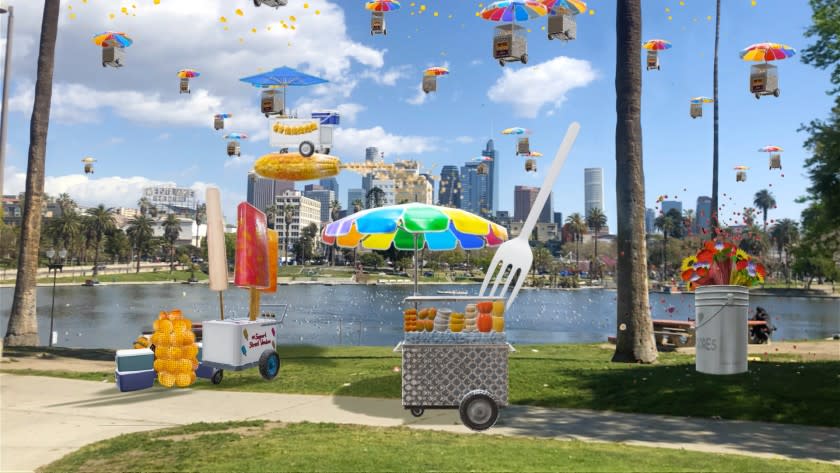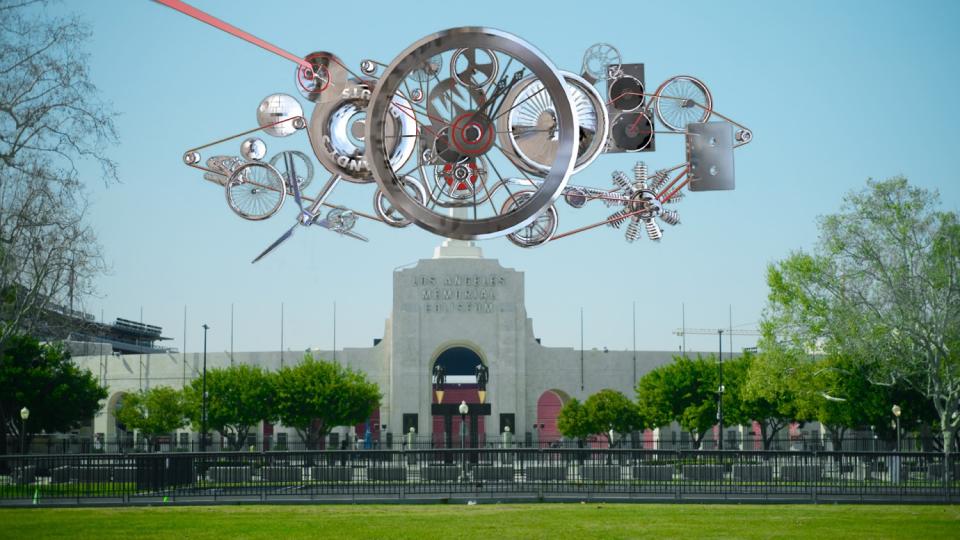Fruit carts flying over MacArthur Park: How you can see LACMA's first AR monuments

An enormous piece of Mexican street corn, slathered in chile powder and Cotija cheese, is soaring over MacArthur Park on Tuesday morning. A runaway orange bounces in the foreground; fruit carts with rainbow-colored sunshades float in the sky.
The augmented reality artwork, “¡Vendedores Presente!” by Ruben Ochoa, is one of five virtual monuments debuting Tuesday, geolocated to sites across the city in a project from the Los Angeles County Museum of Art and Snap Inc., the parent company of Snapchat.
“LACMA × Snapchat: Monumental Perspectives” aims to illuminate untold stories and little-known histories from around Los Angeles. The site-specific works — viewable on the Snapchat app — add to the national conversation around representation and historical accuracy in monuments, murals and other public works of art. When viewers look through their device at the location the work is set in, the digital art appears onscreen.
Ochoa’s work honors the lives and stories of local street vendors and includes a link to vendor resources and nonprofit advocates.
LACMA Director Michael Govan said in the project announcement that the AR monuments “are not only relevant to issues of today — Los Angeles, civic space, community — but also to the medium of art, opening doors to new ways of thinking about art in both physical and virtual spaces.”
LACMA chose the artists in the project. Snap, a member of LACMA’s Art + Technology Lab advisory board, helped to develop the works and provided an undisclosed amount of funding to go toward artist fees, research and promotion, among other things. The Andrew W. Mellon Foundation provided money for related programming, community engagement and other aspects of the project.

Glenn Kaino’s “No Finish Line” is an intricate exploded clock, with visible gears, that whirs and spins above the Los Angeles Memorial Coliseum in Exposition Park. It also can be seen at South L.A.’s Earvin “Magic” Johnson Recreation Area. It incorporates imagery from the men’s marathon route at the 1932 Summer Olympics in L.A. — the Randy’s Donuts sign, a dinosaur skull from the Natural History Museum of Los Angeles County — speaking to the never-ending marathon of intergenerational histories.
Mercedes Dorame’s “Portal for Tovaangar,” on the main LACMA campus, is a cobalt-blue portal filled with red threads that swirl up into the sky and are meant to connect the past, present and future — to close gaps in our city’s history, especially with regard to Indigenous Tovaangar culture.
Ada Pinkston’s “The Open Hand Is Blessed,” situated in Magic Johnson Park, is a memorial to Biddy Mason, who was born enslaved but would go on to be an important L.A. landowner, church founder and philanthropist. I.R. Bach’s “Think Big,” at the same park, integrates text and everyday objects — a lightbulb, a basketball — to inspire empathy and compassion.
LACMA and Snap collaborated in 2019, when the museum presented composer and multimedia artist Christian Marclay’s multimedia installation “Sound Stories,” which mined Snapchat videos for its content.
The works in “Monumental Perspectives” are viewable on Snapchat from anywhere, but the experience may have added resonance when seen at the locations that inspired them.
The project will premiere more virtual monuments in 2021 and in years to come.
This story originally appeared in Los Angeles Times.

